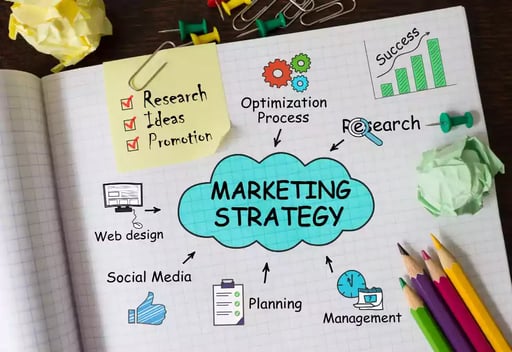In the marketing world, where achieving specific goals often measures success, the concept of SMART objectives for marketing has become a game-changer. This approach can revolutionize a business's marketing strategy, providing a clear, measurable, achievable pathway to success. You'll find S.M.A.R.T. promotional objectives examples and general tips for creating them in this guide. But what exactly are SMART objectives, and how can they transform your marketing efforts? Let's dive in and find out.
Short Summary
-
SMART objectives increase marketing success and provide a clear roadmap for success.
-
Set specific, measurable, achievable, relevant & time-bound goals to motivate teams & maximize the effectiveness of efforts.
-
Regularly monitor progress and adjust accordingly while providing training & support to ensure successful campaigns in 2023!
Understanding SMART Objectives for Marketing
The SMART framework is a strategic goal-setting approach providing a clear and measurable pathway to success. Its acronym stands for Specific, Measurable, Achievable, Relevant, and Time-bound, each representing a crucial aspect of a well-structured objective. This approach assures that your marketing objectives are not dreams but achievable milestones that lead to success.

In marketing, using SMART objectives can lead to a whopping 376% increase in chances of success, as revealed in a survey by CoSchedule. The survey also highlighted that organized marketers, who set clear and well-defined goals, often achieved them. It's an evidence-backed approach to setting goals in marketing - an approach that can take your marketing strategy to new heights.
The SMART Framework
The SMART framework provides a powerful tool to create clear objectives that are easier to monitor, quantify, and reach. It ensures that your marketing goals are not just wishful thinking but achievable targets for a holistic smart objectives marketing plan. For instance, instead of setting a goal like "increase website traffic," a SMART goal would be "increase website traffic by 15% in the next quarter". This sets a clear target and provides a quantifiable measure of success.
Setting specific Key Performance Indicators (KPIs) can help marketers stay focused and ensure they're making progress toward achieving their objectives. KPIs provide a measurable metric that can be tracked over time, providing a clear picture of the progress toward achieving the SMART objectives. They keep you on track, providing a clear direction toward your marketing goals.
Benefits of SMART Objectives in Marketing
SMART objectives aren't just about setting targets; they're about setting the correct targets. They enhance focus, heighten accountability, and enhance communication within the marketing team. They provide a clear roadmap toward success. Setting clear, measurable, and achievable goals ensures that every team member understands what they're working towards, boosting productivity and fostering collaboration.
Furthermore, documenting SMART goals can help you stay motivated and boost your chances of success. It provides a clear vision of success, keeping your team motivated and aligned toward the end goal. When team members know what they're working towards, they're more likely to invest their best efforts in achieving it, leading to a more successful marketing campaign.
Crafting Your SMART Marketing Goals

Crafting SMART marketing objectives involves more than just setting goals; it's about setting the right goals. These goals must be specific, measurable, achievable, relevant, and time-bound. Measuring success or failure allows us to track our progress, identify what works well, and make the necessary adjustments.
By aligning your marketing goals with your Key Performance Indicators (KPIs), you set clear, measurable targets that align with your overall business goals. After matching goals and KPIs with actual time-sensitive expectations, you're ready to take the next step and develop an effective, goal-oriented marketing strategy to set you up for success.
Setting time-bound targets helps to ensure that goals are achieved within a certain timeframe and that progress is monitored accordingly. This motivates you to reach your goals, providing a clear timeline towards success.
Identifying Specific Goals
Identifying specific goals is the first step in setting smart marketing goals and crafting SMART marketing objectives. Being specific ensures that your marketing efforts are focused and have a clear direction. For example, instead of setting a goal like "increase website traffic," a specific would be "increase website traffic by 15% this quarter". This defines a clear target and provides a quantifiable measure of success. Let's explore some SMART marketing goals examples to illustrate this concept further.
By setting SMART objectives, you can ensure that your customer acquisition and marketing efforts are focused and have a positive impact.
Establishing Measurable Metrics
Establishing measurable metrics is a crucial step in the SMART framework. These metrics provide a quantifiable measure of success, helping you track progress and evaluate the success of your objectives. To ensure your goals are achievable, you should ask yourself how you will measure success and what progress indicators you will use.
For instance, if you aim to customer satisfaction, you might measure this through customer satisfaction surveys, online reviews, or feedback forms. By setting clear, measurable goals that align with your KPIs, you ensure that your marketing efforts are directed toward achieving tangible results.
Ensuring Achievability and Relevance

Ensuring that marketing objectives are achievable and relevant to the overall business goals is crucial to maintain focus and motivation within the team. Setting ambitiousis essential, but they should also be realistic. By ensuring that the objectives are achievable, you ensure that your team remains motivated and committed to the task.
Moreover, setting relevant goals ensures that your marketing efforts align with your overall business strategy, leading to a more cohesive and effective marketing campaign. By setting smart goals and implementing the right marketing strategies, you can further enhance the success of your campaign.
Setting Time-bound Targets
Setting time-bound targets is a crucial aspect of the SMART framework. It ensures you have a clear timeline to achieve your objectives and provides a sense of urgency to your marketing efforts. For instance, if your goal is to increase your social media followers in social media marketing campaigns, setting a time-bound target like "Increase social media followers by 20% in the next three months" provides a clear deadline for achieving your goal. This creates a sense of urgency and motivates your team to work towards achieving the target within the set timeframe.
Time-bound targets also help you measure the success of your marketing efforts. By setting a goal, you can achieve this.
Examples of SMART Marketing Objectives in Marketing Efforts

Now that we understand the concept of SMART objectives and their importance in marketing let's look at some practical marketing objectives examples. These examples span different areas within inbound marketing, including content marketing, social media marketing, email marketing, and paid advertising.
Whether it's achieving a 10% increase in website traffic in the next quarter as a content marketing goal or increasing the number of followers on your social media page by 5% in the next month as a social media marketing goal, SMART objectives help provide a clear, measurable, and achievable pathway to success.
But the key to setting effective SMART objectives is to ensure they are specific to your business, align with your overall business objectives, and are achievable within the given timeframe.
Content Marketing
In content marketing, SMART objectives can help you set clear, measurable targets for success for your target audience. For example, if your goal is to increase organic traffic to your blog, a SMART objective might be "increase organic traffic the by 20% over the next quarter".

This goal is specific (increase organic traffic to the blog), measurable (by 20%), achievable (with the right content strategy), relevant (drives more traffic to the website, potentially leading to more conversions), and time-bound (over the next quarter). By tracking your organic blog traffic, over the quarter, you can measure your progress towards achieving this objective and adjust your content strategy as needed.
Social Media Marketing
Social media marketing offers a wealth of opportunities for setting SMART objectives. For instance, if your a real estate agent and your goal is to increase brand awareness and engagement, a SMART objective could be "increase the number of likes and comments on our Facebook posts by 15% over the next month".
This objective is specific (increase the number of likes and comments on Facebook posts), measurable (by 15%), achievable (with a well-planned content and posting schedule), relevant (increases engagement and brand awareness), and time-bound (over the next month). By monitoring your social media analytics over the month, you can track your progress towards this goal and adjust your social media strategy as needed to ensure you are on track to achieving your objective.
Email Marketing
Email marketing also offers an excellent platform for setting SMART objectives. For example, if your goal is to increase engagement with your email newsletters, a SMART objective could be "Increase the open rate for our weekly newsletter by 10% over the next quarter".

This objective is specific (increase the open rate for the weekly newsletter), measurable (by 10%), achievable (with compelling subject lines and content), relevant (increased open rates can lead to increased traffic, conversions, and qualified leads), and time-bound (over the next quarter).
By monitoring your email analytics over the quarter, you can measure your progress toward achieving this objective and adjust your email marketing strategy as needed.
Paid Advertising
Paid advertising is another area where SMART objectives can benefit. For example, if your goal is to increase conversions from your paid advertising campaigns, a SMART objective might be "Increase the conversion rate for our Google Ads campaign by 20% over the next month".
This objective is specific (increase the conversion rate for Google Ads campaign), measurable (by 20%), achievable (with well-crafted ads and landing pages), relevant (increased conversions lead to increased sales), and time-bound (over the next month). By monitoring your advertising analytics over the month, you can measure your progress towards achieving this objective and adjust your advertising strategy as needed to ensure you are on track to achieving your objective.
Monitoring and Adjusting SMART Marketing Objectives
Setting SMART objectives is just the beginning. Monitoring and adjusting these objectives over time is equally important to ensure they align with your overall business goals and drive results. By setting specific, measurable, achievable, relevant, and time-bound goals, tracking progress towards them, and adjusting them as needed, you ensure you stay on track to achieving your marketing objectives.
Regular measurement and tracking of progress are critical for identifying areas of success and areas that need improvement. This allows for data-driven decision-making, helping you optimize your marketing efforts for maximum impact.
Remember, the goal isn't just to set objectives and achieve them. And that requires regular monitoring and adjustments.
Evaluating Progress
Evaluating progress is an integral part of the SMART framework. It allows you to track progress toward your marketing objectives, identify success areas, and pinpoint improvement opportunities. This doesn't just provide a measure of your success and valuable insights that can inform your future marketing efforts.

For instance, if your social media marketing objective was to increase your followers by 20% over the quarter, but you only managed a 15% increase, you need to evaluate why you fell short. Was it because you didn't post enough? Or maybe the content wasn't engaging enough? Evaluating progress helps you answer these questions, providing valuable insights to inform future marketing efforts.
Adjusting Objectives
Adjusting objectives based on performance data is an integral part of the SMART framework. If your marketing objectives aren't being met, it's important to adjust them to ensure they're achievable. This could involve changing the target, adjusting the time frame, or redefining the objective.
Remember, the goal of setting SMART objectives isn't just to set them but to achieve them. So, if your marketing objectives aren't driving the desired results, don't hesitate to adjust them. After all, the ultimate goal is ensuring your marketing efforts drive the desired results and contribute to your overall business goals.
Implementing SMART Objectives in Your Marketing Team

Implementing SMART objectives within your marketing team is crucial to achieving your marketing goals. It involves setting the objectives and ensuring that they are communicated to the team and that the team is provided with the necessary training and support to implement them effectively. This ensures that every team member understands what they're working towards, boosting productivity and fostering collaboration.
But implementing SMART objectives isn't just about setting goals; it's about setting the right goals. These goals must align with your overall business objectives, ensuring that your marketing efforts contribute to the overall success of your business. By setting SMART objectives that align with your business goals, you ensure that your marketing efforts are directed toward achieving tangible results that contribute to your business's success.
Communicating Objectives
Effective communication is crucial for successfully implementing SMART objectives. It's essential to communicate the objectives clearly and concisely so that every team member understands what they're working towards. This could involve regular team meetings, emails, or even one-on-one discussions.
But communicating objectives is more than just telling your team what to do. It's about explaining why they're doing it. By demonstrating how the objectives align with the overall business goals and how achieving them will contribute to the business's overall success, you can ensure your team is aware of the objectives and motivated to achieve them.
Training and Support
Training and support are crucial to implementing SMART objectives effectively. This could involve workshops, seminars, and other resources to help your team effectively understand the SMART framework and how to use it to set objectives. Remember, the goal isn't just to set objectives and achieve them. And that requires equipping your team with the necessary skills and knowledge to implement the SMART framework effectively.
Moreover, ongoing support is crucial for ensuring the effective implementation of SMART objectives. This could involve regular check-ins to monitor progress, providing feedback, and even adjusting the objectives as necessary. By providing your team with the necessary training and support, you can ensure they can effectively implement the SMART framework and achieve your marketing objectives.
Summary
The SMART framework provides a powerful tool for setting marketing objectives that are specific, measurable, achievable, relevant, and time-bound. By implementing this framework within your marketing team, you can set clear objectives contributing to your overall business goals, monitor progress toward achieving these objectives, and make necessary adjustments to ensure ongoing success.
Remember, the goal isn't just to set objectives and achieve them. So, don't be afraid to adjust your objectives to ensure they drive the desired results. After all, the ultimate goal is to ensure your marketing efforts contribute to your business's overall success. So, start setting SMART objectives today and steer your marketing efforts toward success.
Frequently Asked Questions
What are the SMART objectives in marketing?
SMART marketing goals are critical to any successful strategy; they are specific, measurable, achievable, realistic, and time-bound.
Utilizing this framework will help you create relevant objectives and ensure their timely realization.
What are the 5 SMART objectives?
SMART objectives are specific, measurable, achievable, relevant, and time-bound goals. They help to push for success by providing direction and organization to reach the goals and enable taking a grant from ideas to action.
By setting SMART objectives, you can ensure that your goals are clear and achievable. You can also track progress, measure success, and adjust your goals as needed. This will be a success.
What is a SMART objective example?
A SMART objective example could be setting a goal to start a side business selling flowers, spending at least two hours a day planning and marketing the business, and leveraging prior experience to make the switch.
This is an achievable goal that will help the individual reach their desired outcome.
What is used to create the SMART goals quizlet?
Creating SMART goals, quizlet requires using the S.M.A.R.T. format, an effective goal-setting tool designed to help you develop clear, timely and objectives.
This format stands for Specific, Measurable, Attainable, Relevant, and Time-bound. Each of these elements should be included in your goal-setting process to ensure that you set yourself up for success.
By breaking down your goals into these five categories, you will be able to achieve your goals.
How can I implement SMART objectives in my marketing team?
Motivate your marketing team by setting clear SMART objectives, communicating them effectively, and providing necessary training and support to ensure successful implementation.
This will help ensure that your team is focused on the right goals and has the resources needed to achieve them.
July 15, 2023
